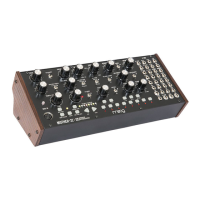15
KEYBOARD OVERVIEW
KEYBOARD
The Mother-32 has a single-octave 13-note keyboard with LEFT/RIGHT arrow buttons used
for selecting the octave of the keyboard. There are 8 available octave settings, indicated by
8 OCTAVE / LOCATION LEDs lit red. The keyboard is also used to access a number sequencer functions.
NOTE: There are two performance modes for the keyboard and octave buttons: Keyboard mode and Step
mode. They determine how these buttons interact with the Sequencer. Details of these operational modes
can be found in the Sequencer section of this manual. The default mode on power up is Keyboard Mode.
GLIDE
Glide, also called portamento or glissando, is used to generate smooth changes
between notes. Glide is applied to notes generated from the Keyboard, MIDI notes,
or the Sequencer. The GLIDE control determines the amount of time it takes for
the VCO to transition from one pitch to the next.
SEQUENCER OVERVIEW AND PANEL CONTROL
The Mother-32 contains a monophonic step sequencer. The Sequencer stores a list of single notes
and expression information called a pattern that can be played back in a loop. As a pattern plays back,
the Sequencer advances through each step and outputs a new note every time a step is reached. Each
pattern can contain up to 32 Steps, and is easily stored in one of 64 available pattern locations. Patterns
are arranged in 8 Banks of 8 patterns each.
The Sequencer directly controls the pitch of the VCO and triggers the EG. Control outputs driven by the
sequencer are the KB CV output, the GATE output and the EG output. Accent signals are routed internally
to the VCF and VCA at a xed level.
SEQUENCER PANEL CONTROLS
The following is an overview of the Mother-32 Sequencer Panel controls. For full details of their
operation, please refer to the “Understanding and Using the Mother-32 Sequencer” section of this manual.
TEMPO/GATE LENGTH
The TEMPO control determines the tempo of the Sequencer. Tempo is
indicated by the Tempo LED located directly above the (SHIFT) button. When
programming Steps in a pattern, this control is used to set the Gate Length for
each Step. Gate Length determines how long each note is held in reference to
the entire duration of its Step.

